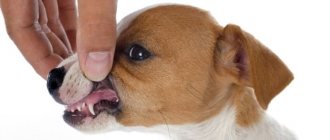Breeding a breed is a responsible and painstaking task that involves you in all aspects of the life of a particular animal. To get good results, breeders need to know how long pregnancy lasts in dogs, how it progresses, and what care the bitch needs. The expectant mother will need the help and support of the owner at every stage of pregnancy. Left unattended, it may not be able to withstand the load and suffer from complications.
How long does gestation last?
On average, the duration of pregnancy in dogs is 55-66 days, that is, about 2 months. The gestation period can shift downward (up to 53 days) or up (up to 71 days) without harm to the puppies if certain factors are present.
What affects timing?
Experienced breeders always note the mating date. It is from this day that they calculate how long pregnancy lasts in dogs. The following factors influence possible deviations from average indicators:
- Number of births
. If a pet is pregnant for the first time, then her babies will not be in a hurry to be born. For more experienced animals, the process takes much less time.
- Size and number of offspring
. The smaller the puppies, the longer they develop in the womb. An earlier exit can only be affected by their number. A small number of babies develop faster.
- Size and age of the pet
. The smaller the animal, the faster the process proceeds. With age, the body weakens, so the dog bears its offspring longer.
- Number of successful matings
. The female can become pregnant after the first mating, but if there is a repeat mating, start counting from there.
In the absence of pathologies, a shift in the estimated date of birth is possible due to later fertilization. This is due to incorrect determination of ovulation. In this case, the sperm will have to wait for the eggs to mature.
Period table
Having figured out how long the duration of pregnancy in dogs is, we can consider its main periods separately. For convenience, they are divided into weeks; the table describes the stages of fetal development and the changes occurring in the expectant mother.
| A week | Puppy development | Pet's condition and care recommendations |
| 1 | After the fusion of the egg and sperm, a zygote is formed. In the first 5-11 days after fertilization, all zygotes are covered with “embryonic” membranes. | Morning sickness may occur. The diet is not changed, but only enriched with vitamins recommended by the veterinarian. Antiparasitic treatment is possible under the supervision of a doctor. |
| 2 | The embryos are still only 0.6 mm long. They are attached to the walls of the uterus, and their outer shell merges with the mucous membrane and forms the placenta. | Interest in male dogs completely disappears. The animal becomes drowsy, may refuse to eat and cuddle up to its owner more often. Daily activity and usual diet are left unchanged. |
| 3 |
| The nipples swell a little, and the skin next to them takes on a more pinkish tint. Lethargy becomes normal. If your appetite increases, your daily food intake may increase. |
| 4 |
| General fatigue and morning sickness are complemented by the appearance of clear mucus that comes out along with urine. The animal is transferred to fractional feeding. Excessively active games and intense training are prohibited. |
| 5 |
| Along with the disappearance of vomiting, appetite increases. Portions are increasing. When dry feeding, food designed specifically for pregnant women is introduced into the diet. Continued vomiting is a reason to contact a veterinarian. |
| 6 |
| Along with your appetite, your weight also increases. The four-legged pet takes more and more care of the offspring, trying to move less and avoid attempts to touch the belly. Reduce the duration of your walk, but try to warm up in the sun. Start preparing the "nest". |
| 7 | In a week, babies grow from 9 cm to 12 cm, and their movement in the abdominal area becomes noticeable even to the owner already at 48-50 days. | The fur next to the nipples begins to fall out. Food enriched with calcium is temporarily excluded. |
| 8 |
| Any activity can lead to premature birth, so keep it to a minimum. Avoid sudden weight changes and increase portions only when necessary. By the end of the 8th week, colostrum appears from the nipples. Take care of finding a surgeon willing to deliver the baby, or start preparing on your own. |
| 9 | The final size of the puppies reaches 16-22 cm and 0.3-0.6 kg. All puppies are born with their eyes closed. | Make sure that your pet understands the purpose of the “nest” and spends most of its time there. Monitor her temperature. As soon as the indicator drops by 1-1.5 °C, get ready for a quick replenishment. |
While caring for your pet, strictly monitor its weight. Sharp jumps are fraught with hormonal disruptions and joint problems.
Calculation of due date
It will not be possible to find out the exact date of birth of the puppies, but it is quite possible to calculate the approximate date. Add to the mating date the average duration of how long the dog stays pregnant. Then try to adjust the resulting figure up or down depending on factors affecting the timing.
Throughout the entire period, the owner must observe the condition of the pet, comparing it with the table. If deviations from the schedule occur, contact your veterinarian immediately to prevent the development of complications.
Fourth to fifth week
During this period, you need to carefully monitor the dogs’ pregnancy day by day, since from the 22nd day you need to change the feeding regimen. Your pet may refuse food due to morning sickness, so it is best to offer food often, but in small portions. From the 23rd day, the embryo grows to a centimeter and develops eyes, nose, ears, jaw and liver. On the 25th day, the formation of teeth, limbs and spine can be observed.
On the 26th day, the embryo is already the size of a walnut, and an experienced veterinarian will be able to diagnose pregnancy by palpation of the abdomen. It is recommended to limit the dog to active games so as not to harm the fruits. From the 27th to the 31st days, “calcification” occurs in the area of the skull and jaws. From the 32nd day, the future pups begin to grow rapidly, so it is worth introducing more protein into the dog’s diet.
Signs of an interesting situation
It is quite difficult to guess that a pet is carrying puppies in the early stages. At first, only behavioral changes are noted that are noticeable to attentive owners. The expectant mother becomes inactive and refuses long walks. She gets nervous in noisy companies and tries to find a secluded place. Her appetite increases or decreases sharply, and she often vomits in the morning.
After detecting these symptoms, be sure to visit a veterinary clinic. More obvious signs appear only a month after fertilization. A pregnant woman's belly becomes rounded and enlarged. Viscous mucus is released from her loop, and the nipples swell.
By the end of 2 months, babies can be palpated, but this is recommended only under the supervision of a veterinarian. Fragile fruits are easy to injure, so avoid self-examination.
At what age does a shepherd dog give birth?
German Shepherds, like all large breed dogs, are distinguished by a late onset of maturity. They continue to grow and develop until they are 15 months old, and early pregnancy in a shepherd will harm both the mother and the fetuses.
But we should not forget that pregnancy and childbirth are a serious burden on the body of a German Shepherd. Good breeders do not breed dogs every time they are in heat, but only once a year, so that internal reserves can be restored. And even under such conditions, the body works “for wear and tear”, so bitches over 8 years old should not be forced to whelp.
In one litter, 6-7 puppies are usually born, but fertile females have 10-12, and even 15 puppies. Firstborns rarely have multiple litters.
At the age of 6-8 years, the German Shepherd gives birth to 1-3 puppies
Differences in timing between dogs of different breeds
To determine the timing of thoroughbred animals, you need to start from their dimensions. The larger they are, the longer it takes to form fruits.
In small
Small breeds (Chihuahuas, Pekingese, Yorkies) carry their young for 55-60 days. Their offspring are always the most numerous.
Due to its modest dimensions, future mothers often encounter gastrointestinal problems. Their enlarged uterus begins to crowd the stomach, so food is made as high in calories as possible, but small in volume.
In the middle ones
Average dogs (boxers, huskies, spaniels) are less likely to suffer from complications, and the number of embryos is always determined by chance. The entire process takes 60-63 days.
In large
Large representatives (wolfhounds, mastiffs, mastiffs) remain pregnant for 63-65 days, but sometimes the period is extended to 72 days. This is due to the cubs being too large and requiring a long time to develop. Despite the small number of offspring, childbirth often occurs with complications due to the problematic passage of overgrown babies through the birth canal.
Our first birth. Perinatal center in Rostov-on-Don
So a month has passed... And only now am I slowly coming to my senses and my “Tsar” gave me a little time to scribble something about that difficult and wonderful day when we were born... The pregnancy was, in general, going well. Of course, there were false diagnoses, a mountain of medications, and two acute respiratory infections. They decided to give birth at the Perinatal Center in Rostov-on-Don. (The impressions from the center are very good, so if anyone is interested in the details, I’ll tell you everything additionally) I’ve been waiting for the birth since the 37th week, I wanted to give birth so badly. (I was such a fool, now I remember this carefree time) And from that time on, once a week we went to the PC to see if there was any progress. 38 weeks - dull (tight cervix, no dilatation), 39 - the same thing, 40 weeks... nothing again (the stomach did not drop, the plug did not come out, no false contractions... WHAT IS THIS?!) The doctor gives us another week, and if nothing happens, I’m going to give up on things.
June 29, 40 weeks and 4 days (day X or PDR











